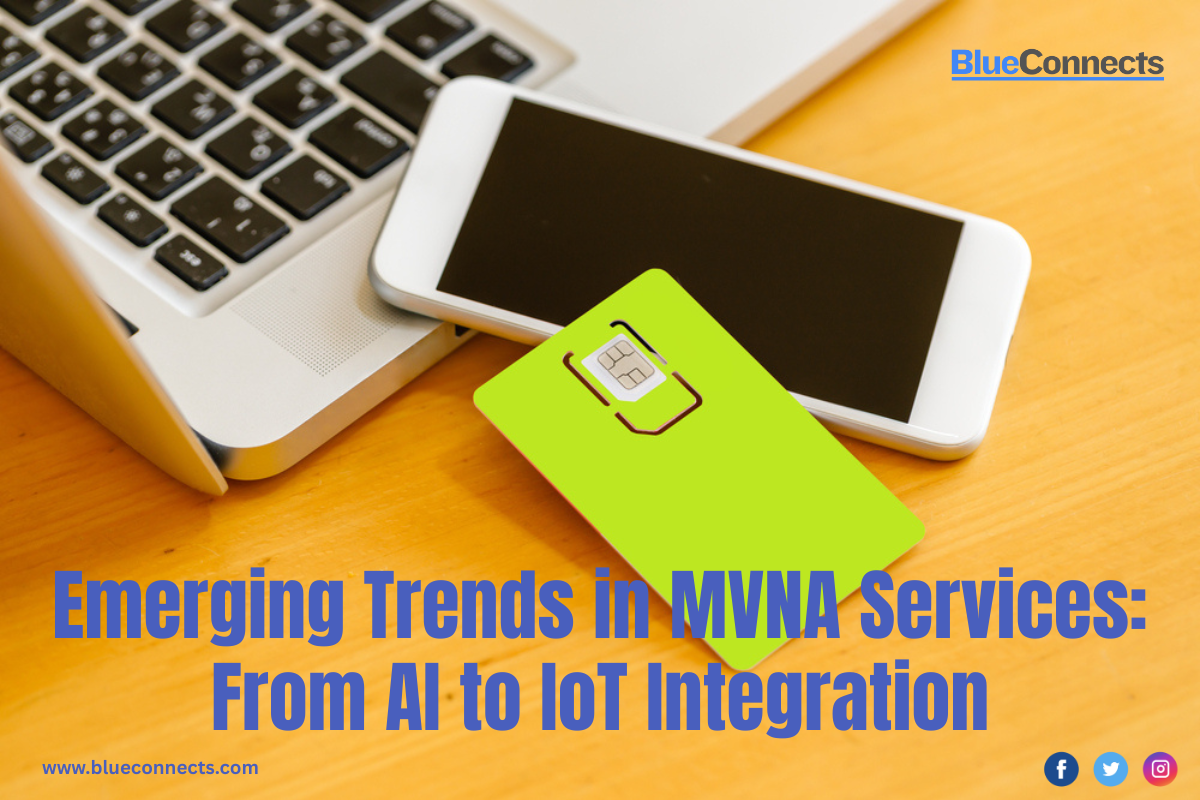Emerging Trends in MVNA Services: From AI to IoT Integration
The Promise of AI in MVNA Services
Artificial intelligence is no longer a futuristic concept but a reality that is transforming industries across the board, including mobile telecommunications. For MVNAs, AI provides a powerful tool to enhance operational efficiency, improve customer experience, and drive innovation in products and services.
One of the most significant applications of AI in MVNA services is in customer support. By leveraging natural language processing (NLP) and machine learning algorithms, MVNAs can develop chatbots and virtual assistants that can handle routine customer inquiries and support requests, freeing up human agents to focus on more complex and high-value tasks. This not only improves the speed and accuracy of customer support but also reduces costs and increases scalability.
Another area where AI is making a significant impact is in network optimization and predictive maintenance. By analyzing vast amounts of network data in real-time, AI algorithms can identify patterns and anomalies that may indicate potential network failures or performance issues. This enables MVNAs to proactively address these issues before they impact customers, thereby reducing downtime and enhancing overall network reliability.
Furthermore, AI can also help MVNAs personalize their services and offerings to individual customers based on their usage patterns, preferences, and behavior. By leveraging machine learning algorithms to analyze customer data, MVNAs can develop targeted marketing campaigns, customized service plans, and personalized content recommendations that enhance the overall customer experience and drive loyalty.
IoT Integration: Connecting the Unconnected
The Internet of Things (IoT) is another significant trend transforming the mobile telecommunications industry, and MVNOs are well-positioned to capitalize on this opportunity. The Internet of Things (IoT) refers to the growing network of connected devices and sensors that can communicate and exchange data over the internet, ranging from smart home appliances to industrial equipment and beyond.
For MVNAs, IoT represents a massive untapped market that can drive new revenue streams and business models. By leveraging their existing network infrastructure and expertise in mobile connectivity, MVNAs can offer IoT services and solutions to enterprises and consumers alike, enabling them to connect and manage their devices seamlessly and securely.
One of the most promising applications of IoT in MVNA services is in the area of smart cities and infrastructure. By deploying IoT sensors and devices across urban environments, MVNAs can help cities optimize their operations, from traffic management to waste collection and beyond. This not only improves the quality of life for citizens but also creates new opportunities for MVNAs to partner with local governments and other stakeholders in the innovative city ecosystem.
Another area where IoT is driving innovation in MVNA services is in the field of industrial automation and machine-to-machine (M2M) communication. By connecting industrial equipment and sensors to the internet, MVNAs can enable remote monitoring, predictive maintenance, and real-time optimization of production processes, helping enterprises increase efficiency, reduce downtime, and improve overall performance.
The Convergence of AI and IoT
While AI and IoT are powerful trends in their own right, it is their convergence that truly unlocks the full potential of MVNA services. By combining the intelligence of AI with the connectivity of IoT, MVNAs can create a new generation of intelligent, adaptive, and personalized services that can revolutionize the way we live, work, and communicate.
For example, by leveraging AI algorithms to analyze data from IoT sensors and devices, MVNAs can develop predictive maintenance solutions that can detect and prevent equipment failures before they occur, saving enterprises millions of dollars in downtime and repair costs. Similarly, by using AI to optimize IoT network performance and resource allocation, MVNAs can ensure that connected devices can communicate and exchange data seamlessly and efficiently, even in challenging environments such as remote or congested areas.
Furthermore, the convergence of AI and IoT can also enable MVNAs to offer new types of services and experiences that were previously unimaginable. For example, by combining IoT sensors with AI-powered virtual assistants, MVNAs can create brilliant homes that can anticipate and respond to the needs and preferences of their occupants, from adjusting the temperature and lighting to ordering groceries and scheduling appointments.
The Challenge of Security and Privacy
While the emergence of AI and IoT in MVNA services offers tremendous opportunities for innovation and growth, it also poses significant challenges in terms of security and privacy. As more and more devices and data are connected to the internet, the risk of cyberattacks, data breaches, and other security threats increases exponentially.
For MVNAs, ensuring the security and privacy of their customers' data and devices is a top priority and a critical differentiator in the market. This requires a multi-layered approach that encompasses everything from network security and encryption to device authentication and access control.
One of the key challenges in securing IoT devices is their sheer diversity and scale. Unlike traditional mobile devices, such as smartphones and tablets, IoT devices come in a wide range of shapes and sizes, from tiny sensors to industrial machinery, and often have limited processing power and memory to support advanced security features. This requires MVNAs to develop flexible and scalable security solutions that can adapt to the unique requirements of each device and use case.
Another challenge is striking a balance between security, usability, and convenience. Customers expect their IoT devices and services to be easy to use and seamlessly integrated into their daily lives, without requiring complex configurations or frequent updates. This requires MVNAs to develop security solutions that are transparent, automated, and user-friendly, while still providing robust protection against cyber threats.
Regulatory and Compliance Considerations
In addition to security and privacy, MVNAs must also navigate a complex and evolving regulatory landscape related to AI and IoT services. As these technologies become more prevalent and pervasive, governments and regulatory bodies worldwide are grappling with how to balance innovation and consumer protection while ensuring a level playing field for all market participants.
For MVNAs, this means staying up-to-date with the latest regulatory developments and ensuring that their services and practices comply with all applicable laws and standards. This includes everything from data protection and privacy regulations, such as the GDPR and CCPA, to industry-specific guidelines, including those related to network neutrality and spectrum allocation.
Furthermore, MVNAs must also be proactive in engaging with regulators and policymakers to shape the future of AI and IoT regulation in a way that promotes innovation and competition, while safeguarding consumer rights and interests. This requires a collaborative and transparent approach that involves all stakeholders, including industry associations, consumer advocacy groups, academia, and civil society.
The Future of MVNA Services
As AI and IoT continue to evolve and mature, the future of MVNA services looks bright and full of possibilities. By leveraging these technologies to create new types of services and experiences, MVNAs can differentiate themselves in an increasingly crowded and commoditized market while also driving growth and profitability.
However, to succeed in this new era of intelligent and connected services, MVNAs must also be willing to adapt and transform their business models and operations. This may involve everything from investing in new skills and capabilities, such as data science and machine learning, to forging new partnerships and ecosystems with technology providers, device manufacturers, and other stakeholders.
Ultimately, the MVNAs that will thrive in the future will be those that can combine the power of AI and IoT with a deep understanding of customer needs and preferences, while also navigating the complex regulatory and security landscape with agility and resilience. By doing so, they can not only survive but also thrive in the face of disruption and change, while also making a positive impact on society and the world at large.
The emergence of AI and IoT in MVNA services represents a significant shift in the mobile telecommunications industry, offering both challenges and opportunities for MVNAs and their customers alike. By leveraging these technologies to create new types of services and experiences, MVNAs can differentiate themselves in the market, drive growth and profitability, and make a positive impact on society and the environment.
However, to succeed in this new era of intelligent and connected services, MVNAs must also be willing to invest in new skills and capabilities, forge new partnerships and ecosystems, and navigate a complex and evolving regulatory and security landscape with agility and resilience.
As we look to the future, one thing is clear: the convergence of AI and IoT will continue to shape and transform the MVNA landscape in ways that we can only begin to imagine. By staying ahead of the curve and embracing these trends with innovation and a customer-centric approach, MVNAs can not only survive but also thrive in the face of disruption and change, while making a positive impact on the world around us.

